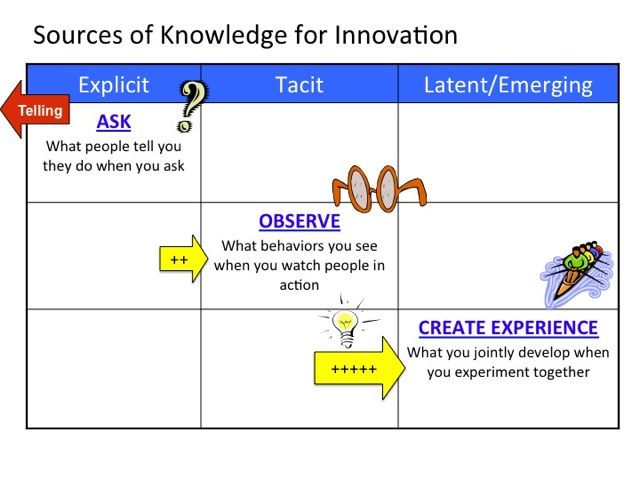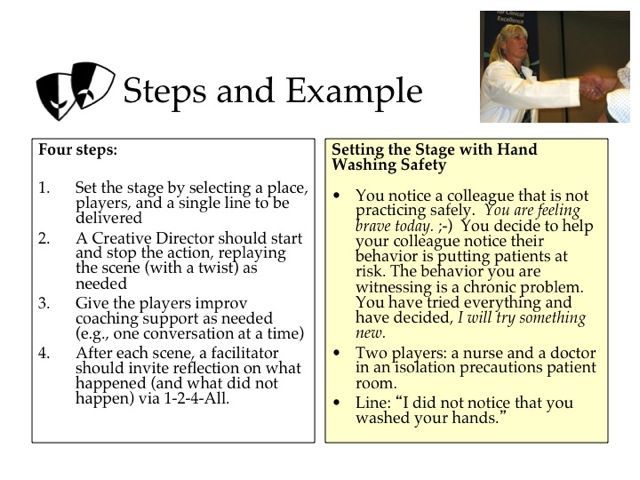![]() Improv Prototyping
Improv Prototyping
Develop Effective Solutions to Chronic Challenges While Having Serious Fun (20 min. per round)
To be playful is not to be trivial or frivolous, or to act as if nothing of consequence will happen. On the contrary, when we are playful with one another, we relate as free persons, and the relationship is open to surprise; everything that happens is of consequence, for seriousness is a dread of the unpredictable outcomes of open possibility. To be serious is to press for a specified conclusion. To be playful is to allow for unlimited possibility. – James Carse
What is made possible? You can engage a group to learn and improve rapidly from tapping three levels of knowledge simultaneously: (1) explicit knowledge shared by participants; (2) tacit knowledge discovered through observing each other’s performance; and (3) latent knowledge, i.e., new ideas that emerge and are jointly developed. This powerful combination can be the source of transformative experiences and, at the same time, it is seriously fun. Participants identify and act out solutions to chronic or daunting problems. A diverse mix of people is invited to dramatize simple elements that work to solve a problem. Innovations represented in the Improv sketches are assembled incrementally from pieces or chunks that can be used separately or together. It is a playful way to get very serious work done!
 Sources of Knowledge & Innovation, adapted from Alan Duncan, MD (Mayo Clinic), designed for VHA Health Foundation (2006).
Sources of Knowledge & Innovation, adapted from Alan Duncan, MD (Mayo Clinic), designed for VHA Health Foundation (2006).
Five Structural Elements – Min Specs
1. Structuring Invitation
- Invite participants to identify a frustrating chronic challenge in their work, then to playfully experiment, invent, and discover better ways to address the challenge by acting out the situation and possible solutions.
2. How Space Is Arranged and Materials Needed
- An open space or stage at the front or in the middle of a room
- If needed, props for the scene or scenes to be offered
- Small clusters of chairs to accommodate all participants
3. How Participation Is Distributed
- Everyone is included either as players or observers
- A few volunteers to be “players”
- Everyone else acts as observers and evaluators, then co-creative players
4. How Groups Are Configured
- One small group of players on “the stage”
- All others, the observers, in small groups in front or around the stage
5. Sequence of Steps and Time Allocation
- Explain what will be done and describe the sequence of steps. 2 min.
- Set the stage by describing the scenario that will be acted out and the various roles. 3 min.
- Players on stage enact the scene. 3–5 min.
- Each small observer group debriefs with 1-2-4-All to identify successful and unsuccessful “chunks” from the scene that they just observed. 5 min.
- Each observer group then pieces together the successful chunks into a new prototype and volunteers from within the group act out the new prototype for their own group only. 5 min.
- Participants from one of the observer groups who judge that they have an improved prototype volunteer to come on stage and enact their version in front of the whole group. 3–5 minutes.
- Continue with as many rounds as necessary to arrive at one or more prototypes that are good enough to put into practice.
WHY? Purposes
- Enable people to act their way into new thinking: Improv Prototyping is a rehearsal for real life
- Break a task that seems daunting into smaller pieces
- Engage and focus everyone’s imagination on solving messy challenges
- Break through frozen or resistant behaviors
- Create an engaging and fun alternative to dry or unproductive training
- Work across functional and disciplinary barriers
- Help people learn from peers that have behaviors that solve the problem
Tips and Traps
- Be as inclusive as possible: invite everyone in different roles to join in
- Draw meaningful themes and dramatic lines for each scene from Discovery & Action Dialogues and Simple Ethnography
- Consider creating three supporting roles depending on the complexity of the scenario: stage manager, creative director, and facilitator.
- Replay scenes that do not capture the imagination or generate new ideas
- Invite people to let go of assumptions and biases by putting themselves in the shoes of others, e.g., doctor plays nurse and nurse plays doctor, student plays professor
- Invite creative director to gently redirect the players as needed
Riffs and Variations
- With the goal of discovering better (and worse) actions, invite the audience to replay the scene in small groups. Start with separate small groups staging their own impromptu Improvs, then invite face-off competitions judged by an “applause-o-meter”
- Link to and string with Design StoryBoards, Shift & Share, and User Experience Fishbowl to help spread the innovations (specify what is and what could be)
Examples
- Hospital trainers have substituted Improv Prototyping for conventional courses
- For sales reps to invent new ways to interact with their customers
- For managers to make their interactions with people who report to them more productive
- For health-care providers to practice end-of-life and palliative-care conversations with patients and family members
- For teachers to discover effective responses to disruptive classroom behaviors
- For training young nurses to stand their ground on safety issues (see “Dramatizing Behavior Change to Stop Infections” in Part Three: Stories from the Field).
Attribution: Liberating Structure developed by Henri Lipmanowicz and Keith McCandless. Inspired by Antonas Mockus (former mayor of Bogota) and Improv artists.
Collateral Material
Below: Presentation materials we use to introduce Improv Prototyping

